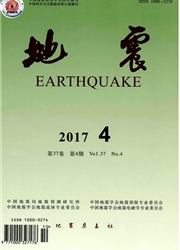

 中文摘要:
中文摘要:
2010年玉树MW6.9地震发生后,已有学者利用DInSAR技术得到了该次地震的同震形变场,并在此基础上反演了其震源破裂滑动分布。本文以提高玉树地震同震形变场准确度作为出发点,设计了一种新的解缠方式获取相应的同震形变场:首先沿地表同震破裂迹线将In—SAR干涉图像分割成上下两部分,然后利用网络流解缠算法对其分别进行相位解缠,最后通过统计重叠部分的相位一致性信息将两部分结果进行拼接。利用震中区GPS同震位移数据对分区解缠结果进行验证。结果表明:相对于整体解缠结果,分区解缠方式得到的最大视线向沉降值由42.6cm增加到48.1cm,所得结果与GPS观测结果更加接近,采用分区解缠方式提高了断层附近形变场的准确性。
 英文摘要:
英文摘要:
Coseismic deformation field of the 2010 Yushu Mw6.9 earthquake has been derived from DInSAR technique and rupture slip distribution has been obtained using inver- sion approaches in a number of previous studies. In this paper, we have designed a novel unwrapping approach, in an effort to derive a higher precision for coseismic deformation of the Yushu earthquake. The InSAR interferogram was divided into upper and lower subre- gions along the surface rupture trace. Unwrapping is performed for the 2 subregions re- spectively using network flow algorithm. Subsequently, the unwrapped interfrograms are stitched together to obtain the overall eoseismic deformation, analyzing the statistical con- sistence of overlapping zone. We use three-dimensional coseismic displacements from GPS to validate the InSAR-derived deformation field of the novel approach. The result shows that, with respect to unwrapping for entire interferogram, subregion unwrapping approach can improve the accuracy of coseismic deformation accuracy. The maximum sinking value increases to 48.1 cm for subregion phase unwrapping from 42.6 cm for the approach of en- tire region phase unwrapping, with the former closer to the GPS-derived coseismic displacement.
 同期刊论文项目
同期刊论文项目
 同项目期刊论文
同项目期刊论文
 期刊信息
期刊信息
